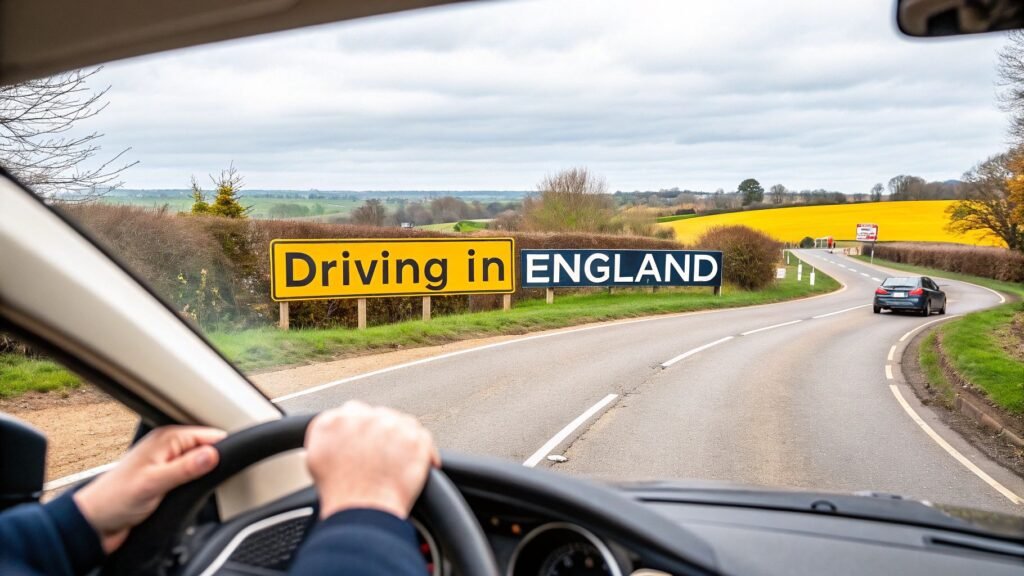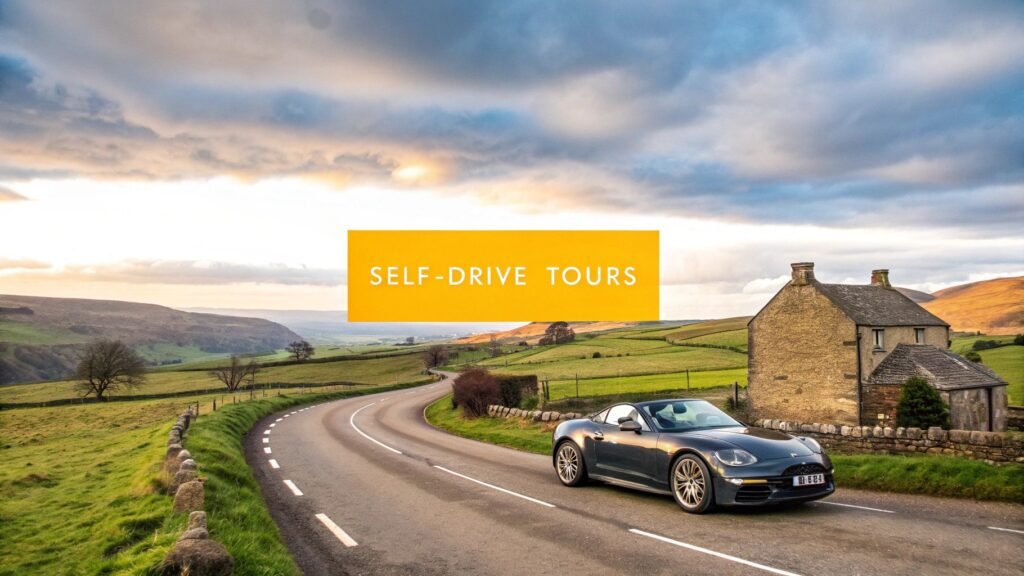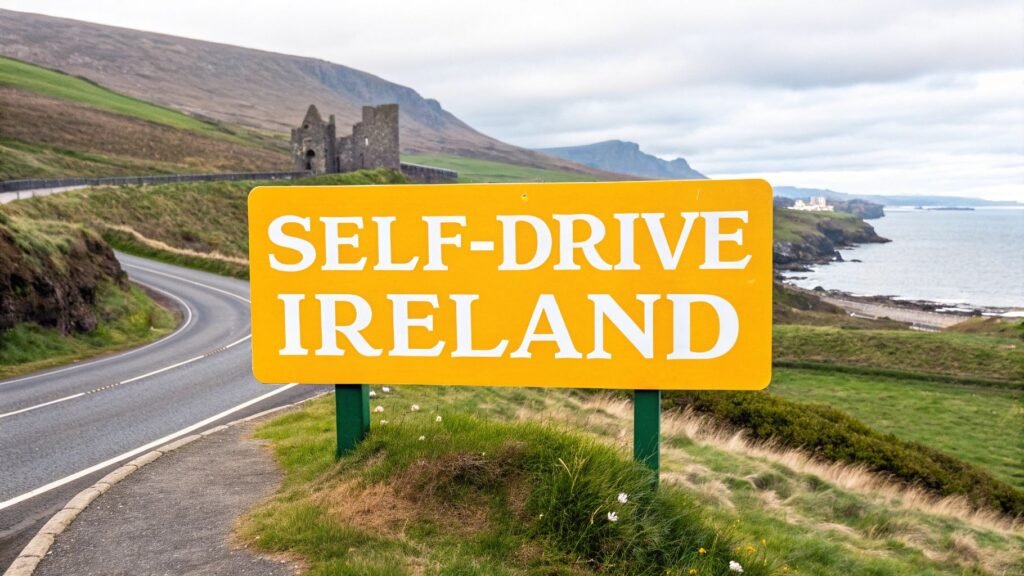Embarking on a journey through England by car offers unparalleled freedom to discover its historic cities, charming villages, and stunning countryside. However, for many visitors, the prospect of navigating unfamiliar roads can be daunting. From driving on the left to mastering the art of the roundabout, English roads have their own unique character and rules. This guide is designed to demystify the experience, providing you with practical, actionable driving in England tips to help you feel prepared and confident behind the wheel.
We will cover essential skills, including navigating narrow country lanes, understanding motorway etiquette, and deciphering parking restrictions. Before hitting the road, it's also crucial to understand essential legal requirements. For instance, UK residents should know how to ensure your UK driving license is valid, while international visitors must confirm their license is accepted.
This comprehensive list moves beyond the obvious, offering detailed advice on everything from speed limits and traffic enforcement to preparing for unpredictable British weather. By mastering these core concepts, you can transform a potentially stressful drive into a memorable adventure, allowing you to focus on the joy of exploring England's diverse landscapes at your own pace.
1. Drive on the Left Side of the Road
The most fundamental rule and one of the essential driving in England tips is this: traffic flows on the left. For visitors from North America or most of continental Europe, this requires a complete mental reset. Your driving instincts, from lane positioning to turning at junctions, must be consciously rewired.
In England, the driver’s seat is on the right-hand side of the car. This positioning keeps the driver towards the centre of the road, offering a better view of oncoming traffic. This single change affects everything, including your mirrors, gear stick operation (for manual cars), and overall spatial awareness.
Mastering Left-Side Driving
Adjusting can feel disorienting at first, but with a deliberate approach, you can build confidence quickly. The key is to consciously override your old habits until the new pattern feels natural.
- Initial Practice: Before tackling motorways or busy city centres, spend some time in a quiet residential area or a large, empty car park. Practise turning left and right, getting a feel for the car's dimensions from the new perspective.
- Mantra for Positioning: A helpful mental trick is to repeat the phrase, "driver in the gutter, passenger in the middle." This helps you remember that as the driver, you should be positioned closer to the kerb (the "gutter") on your left, not the centre line.
- Navigating Junctions: Turning left is straightforward, similar to a right turn in a right-hand drive country. Turning right, however, requires you to cross oncoming traffic, so extra caution is needed. Always give way to vehicles approaching from your right.
- Roundabout Rules: Roundabouts are extremely common in England. You must always enter them by turning left, proceeding in a clockwise direction, and giving way to traffic already on the roundabout (approaching from your right).
This simple process flow diagram illustrates the core principles of driving on the left.
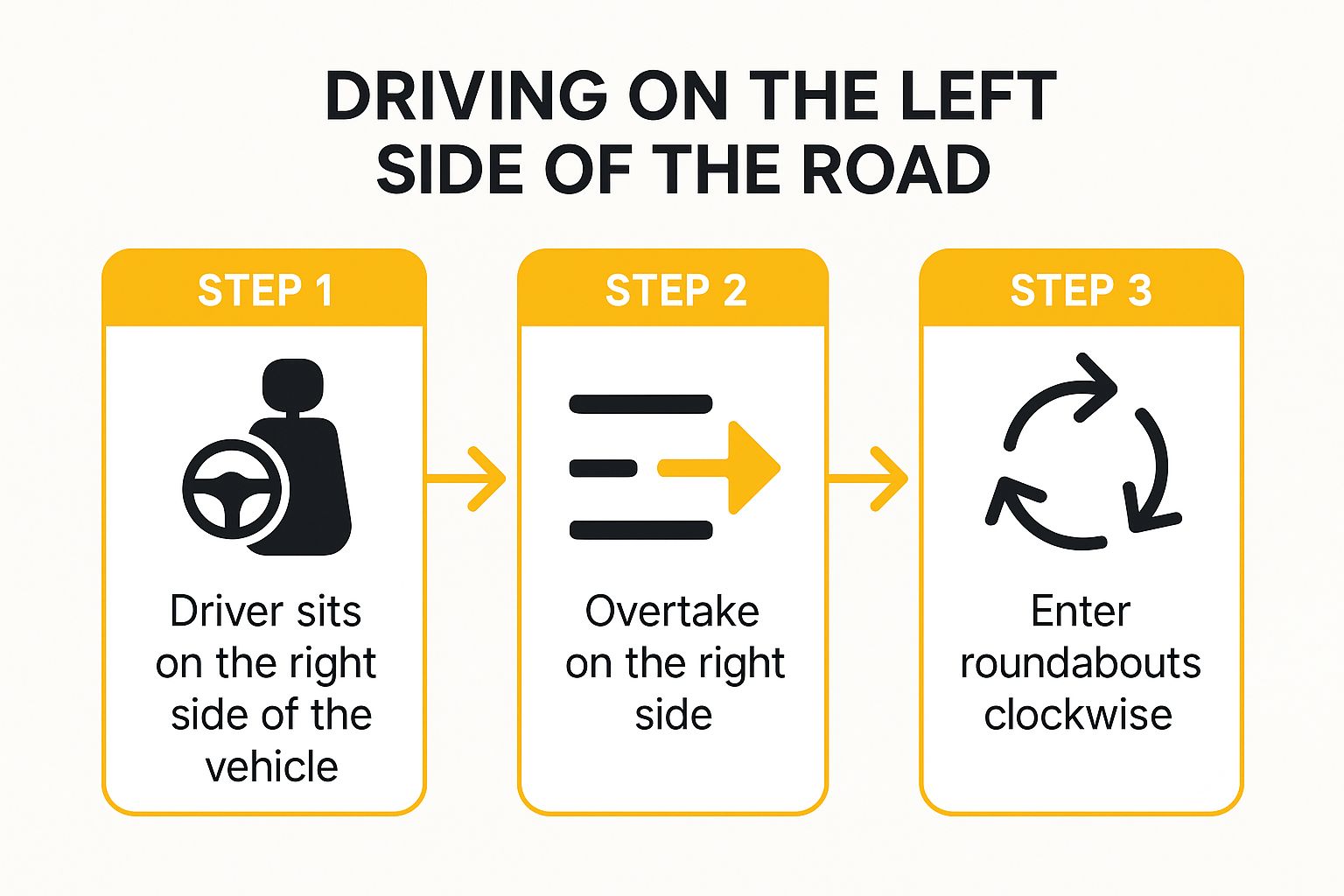
Visualising this sequence helps reinforce the three most critical adjustments: your position in the car, how you overtake, and the direction of travel on roundabouts. For those planning a self-drive holiday, mastering these fundamentals is non-negotiable for a safe and enjoyable journey through England's historic landscapes. To get more context on what a self-drive tour entails, you can learn more about exploring England by car.
2. Master Roundabout Navigation
A core part of the UK road network, roundabouts are designed to keep traffic moving efficiently and are a crucial skill to acquire for anyone planning on driving in England. With over 25,000 across the country, from simple mini-roundabouts in towns to complex multi-lane gyratories, understanding them is non-negotiable. For many visitors, they can be intimidating, but they are statistically safer than traditional junctions, reducing serious accidents by a significant margin.
Unlike four-way stops common in North America, traffic flows continuously. The fundamental principle is to give way to traffic approaching from your right that is already on the roundabout. You must always travel in a clockwise direction. This system prevents the long queues often associated with traffic lights, making journeys smoother once you are comfortable with the rules.
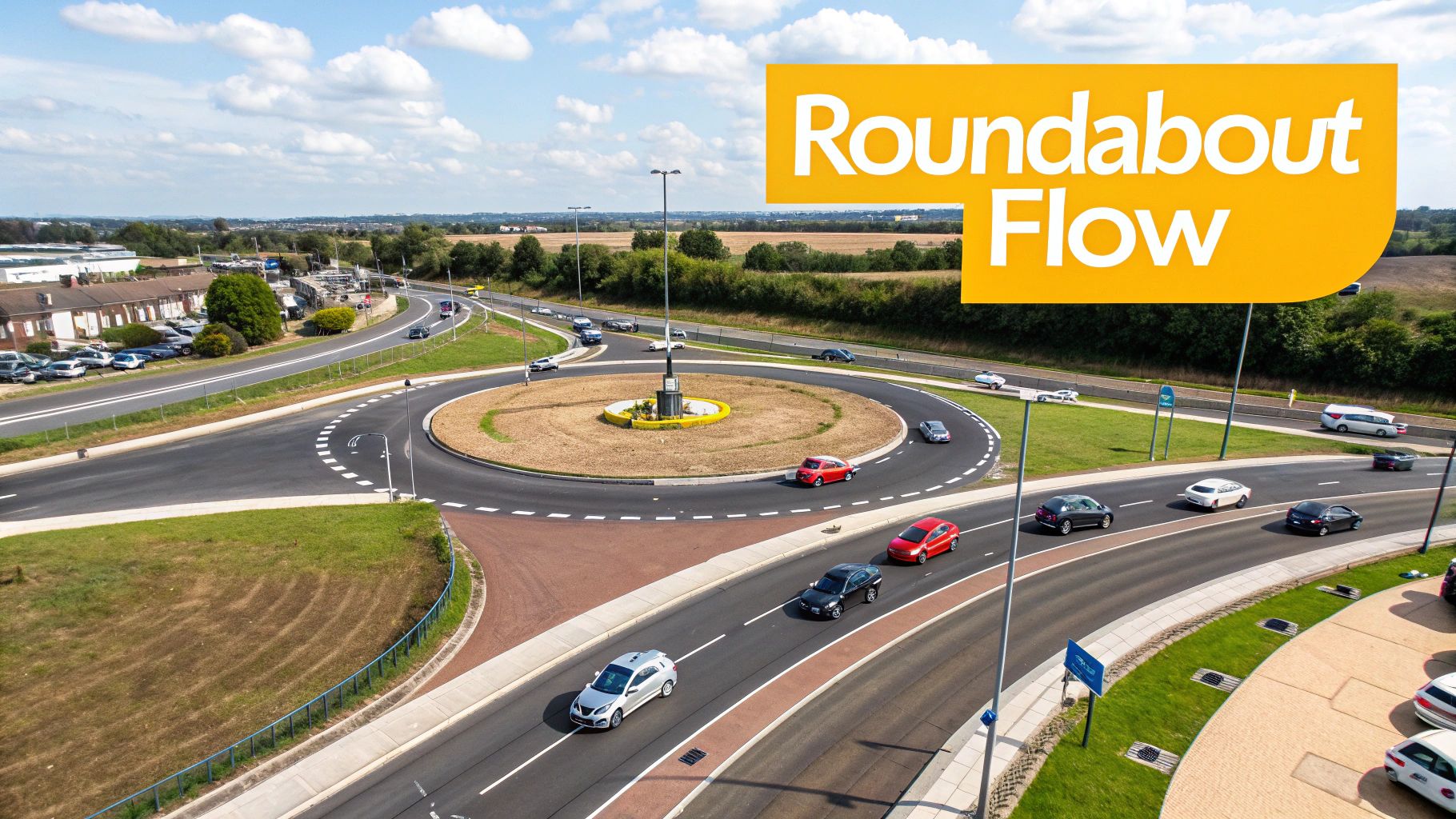
Mastering Roundabout Rules
Confidence on roundabouts comes from knowing the procedure before you arrive at the junction. It's all about observation, lane discipline, and clear signalling. While most are straightforward, some, like Swindon's infamous "Magic Roundabout" with its multiple mini-roundabouts, highlight the importance of mastering the basics.
- Approach and Observe: As you approach, check road signs and markings to determine which lane you need for your intended exit. Slow down and be prepared to stop.
- Lane Discipline is Key: For exits at or before the 12 o'clock position (left or straight on), you should typically use the left-hand lane. For exits after the 12 o'clock position (turning right), you should generally select the right-hand lane.
- Give Way to the Right: Your priority is to yield to any vehicle already circulating on the roundabout. Only enter when there is a safe gap in the traffic flow from your right.
- Signal Your Intentions: Signal left as you pass the exit just before the one you intend to take. This clearly communicates your plan to other drivers. Do not stop on the roundabout itself unless forced to by traffic ahead.
These rules form the basis of a safe and efficient roundabout technique. Properly navigating them is one of the most practical driving in England tips you can learn, ensuring you can handle one of the most common features of the country's roads with confidence.
3. Understand UK Road Signs and Markings
Beyond driving on the left, understanding the UK’s unique system of road signs and markings is one of the most vital driving in England tips for any visitor. The colours, shapes, and symbols you encounter provide non-negotiable instructions and warnings that differ significantly from those in North America and even parts of Europe. Misinterpreting a sign can lead to fines, dangerous situations, or simply getting lost.
Road signs in England are categorised by shape and colour to convey specific types of information. Circular signs give orders, triangular signs warn of upcoming hazards, and rectangular signs provide information. For instance, a red circle is prohibitive (e.g., 'No Entry'), while a blue circle indicates a mandatory instruction (e.g., 'mini-roundabout ahead').
Mastering Road Signs and Markings
Familiarising yourself with the most common signs before you start your engine will make your journey safer and far less stressful. The official Highway Code is the definitive guide, but focusing on a few key types will cover most situations you'll encounter on your travels.
- Key Sign Shapes: Remember this simple rule: circles give orders, triangles warn, and rectangles inform. This helps you instantly grasp the sign's purpose. For example, a triangle showing a bicycle warns of a cycle route ahead, while a blue circle with a bicycle requires you to use a cycle-only lane.
- The National Speed Limit: A white circular sign with a single black diagonal line indicates that the national speed limit applies. This is not a "no limit" sign. The limit is 70 mph on motorways and dual carriageways and 60 mph on single-carriageway roads, unless otherwise signposted.
- Parking Restrictions: Yellow lines along the edge of the road relate to parking. A single yellow line means parking is restricted during certain times (check nearby signs for details), while a double yellow line means no parking at any time.
- Box Junctions: These are yellow criss-cross grids painted on the road, usually at busy intersections. You must not enter the box unless your exit road is clear. The only exception is if you are turning right and are only stopped by oncoming traffic.
4. Navigate Narrow Country Roads and Passing Places
A core part of exploring rural England involves driving on roads that are often ancient, winding, and incredibly narrow. Many of these routes, especially in areas like the Cotswolds or the Lake District, are single-track lanes originally designed for horse-drawn carts. One of the most crucial driving in England tips for any self-drive tourist is learning to navigate these unique roads with confidence and courtesy.
These lanes are characterised by high hedgerows, stone walls, and blind corners, with designated 'passing places' as the only way for two cars to pass each other. Mastering the etiquette of these roads is essential for a stress-free journey through England’s most picturesque landscapes, from the rolling hills of the Yorkshire Dales to the coastal lanes of Devon and Cornwall.
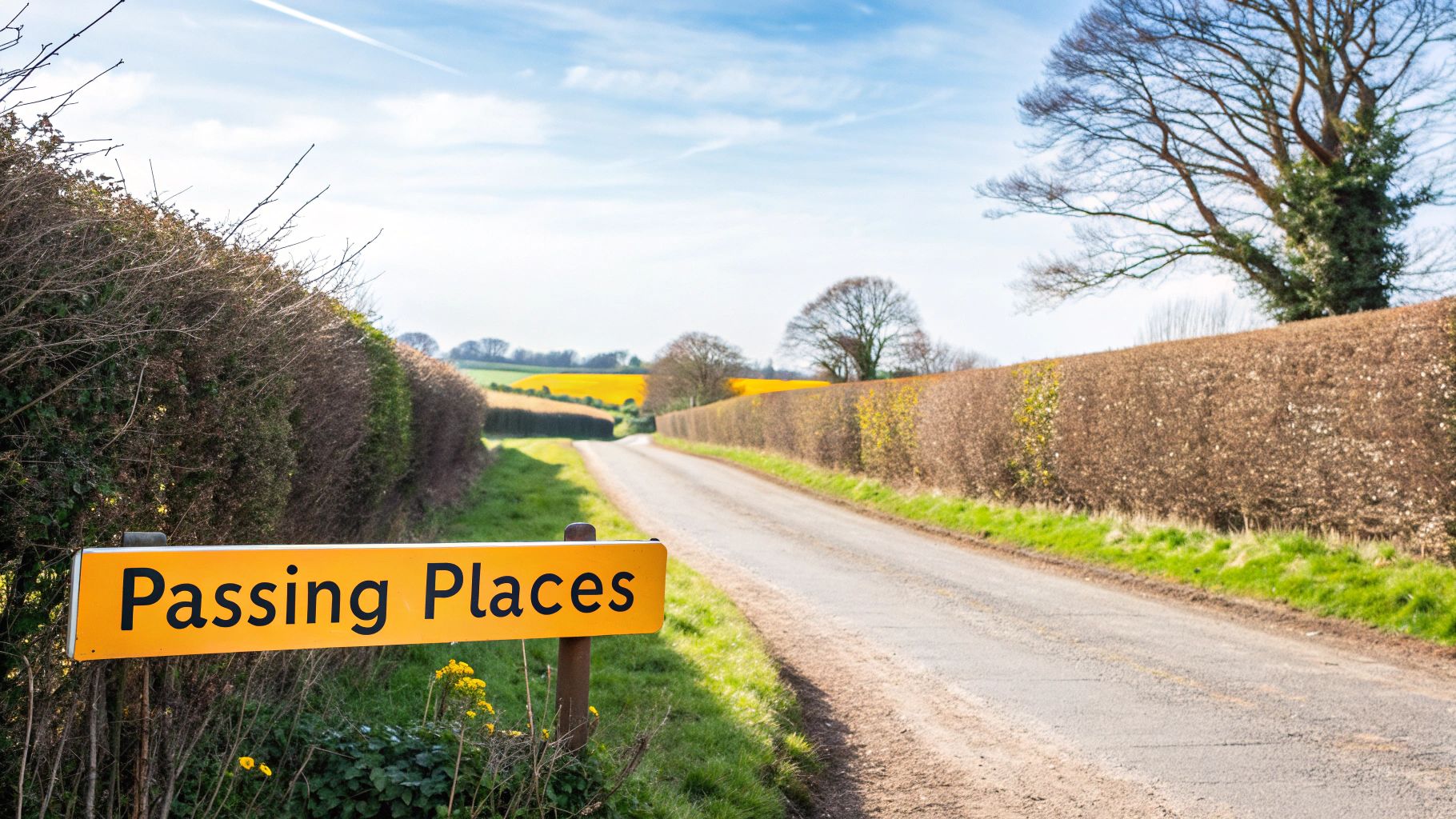
Mastering Rural Lane Etiquette
Navigating single-track roads is less about rules and more about cooperation and forward-thinking. The primary goal is to keep traffic flowing smoothly and safely, which requires a different mindset from motorway or city driving.
- Anticipate and Prepare: Drive slowly and look far ahead. Scan for passing places as you go, noting the last one you passed. If you see an oncoming vehicle, the driver who is closer to a passing place should pull into it or reverse back to it.
- Use Passing Places Correctly: A passing place is a small cutout on the side of the road. If the space is on your left, pull into it. If it is on your right, stop opposite it to allow the other car to drive into the space and around you.
- The Unwritten Right-of-Way: Generally, the vehicle travelling uphill has priority, as it is more difficult to start a hill climb from a standstill. However, this is a convention, not a legal rule. Be prepared to cede priority for the sake of safety and courtesy.
- Communicate Clearly: A quick flash of your headlights can signal to an oncoming driver that you are waiting for them to pass. A wave of the hand is the customary way to say thank you after a successful manoeuvre.
- Be Patient and Cautious: You may encounter tractors, livestock, cyclists, or walkers. Sound your horn gently before a completely blind bend and be prepared to fold in your wing mirrors for extremely tight squeezes. Above all, patience is key.
5. Master Motorway Driving Techniques
Another of the most crucial driving in England tips involves navigating the country’s high-speed motorways, designated by an 'M' prefix (e.g., M25, M1, M6). These multi-lane carriageways are the arteries of the nation, but they operate with a strict set of rules and etiquette designed to maintain traffic flow and ensure safety at speed.
Unlike A-roads or city streets, motorways demand constant awareness and adherence to specific protocols. The key principles are lane discipline, safe following distances, and understanding modern systems like smart motorways. Proper technique not only keeps you safe but also helps prevent traffic congestion for everyone.
Mastering Motorway Etiquette
Confidence on the motorway comes from understanding the unspoken rules as much as the official ones. The flow of traffic depends on every driver playing their part correctly.
- Keep Left Unless Overtaking: The left-hand lane is the default driving lane. You should always remain in this lane unless you are overtaking slower vehicles. Once you have finished overtaking, you must move back into the left-most available lane. Lingering in the middle or right-hand lane (known as "lane hogging") is a fineable offence and disrupts traffic flow.
- The Two-Second Rule: Always maintain at least a two-second gap between your vehicle and the one in front. To check this, watch the vehicle ahead pass a stationary object (like a bridge or signpost) and count "one-thousand-one, one-thousand-two." If you pass the same object before finishing, you are too close. Double this gap in wet or poor weather conditions.
- Signalling and Mirrors: Check your mirrors frequently, especially your blind spots, before making any manoeuvre. Signal your intention to change lanes well in advance to give other drivers time to react.
- Understanding Smart Motorways: Many motorways, including sections of the M25 and M1, are now "smart motorways." These use technology to manage traffic, often converting the hard shoulder into a live lane during busy periods. Pay close attention to the overhead electronic signs, which will display variable speed limits and indicate which lanes are open or closed with a red 'X'.
Adhering to these motorway rules is essential for any road trip, especially for those planning longer journeys across the country. For more information on planning your own journey, you can learn about the freedom of a self-drive tour of England.
6. Understand Speed Limits and Traffic Enforcement
A critical aspect of a stress-free journey is adhering to the speed limits, making this one of the most important driving in England tips. Unlike some countries where limits can feel like mere suggestions, in England they are strictly enforced through an extensive network of cameras and police patrols. Understanding the system is vital to avoid hefty fines and penalty points on your licence.
Speed limits in the UK are displayed in miles per hour (mph) and vary based on the type of road and whether it's in a built-up area. A national speed limit sign (a white circle with a black diagonal stripe) indicates 70 mph on motorways and dual carriageways, and 60 mph on single carriageways, unless signs state otherwise. In towns and cities, the limit is typically 30 mph, with many areas now introducing 20 mph zones.
Navigating Enforcement and Staying Compliant
The UK employs sophisticated technology to enforce these limits, so assuming you won't get caught is a risky strategy. Awareness and caution are your best tools for staying compliant and safe.
- Types of Cameras: Be aware of different enforcement methods. You'll encounter fixed "Gatso" cameras at accident blackspots, discreet average speed cameras that monitor your speed over several miles on major A-roads and motorways, and mobile police speed traps that can be set up anywhere.
- Use Your Sat-Nav: Most modern GPS systems or navigation apps (like Waze or Google Maps) display the current speed limit for the road you are on. This is an invaluable tool, especially when signage is not immediately obvious.
- Watch for Repeater Signs: After passing a junction or entering a new speed zone, look for smaller "repeater" signs that remind you of the current limit. This is particularly useful on long stretches of road where it's easy to forget.
- Beware of Roadworks: Temporary speed limits in roadworks sections are common and are often enforced by average speed cameras. These limits are in place for the safety of road workers and drivers, so they must be strictly observed.
- Consequences are Serious: In the UK, accumulating 12 penalty points on your licence within a three-year period typically results in a driving ban. Fines can be substantial, so driving responsibly is not just about safety, it's also about protecting your wallet and your ability to continue your journey.
7. Navigate Parking Restrictions and Payment Systems
One of the most crucial yet often overlooked driving in England tips involves mastering the country's complex parking landscape. Regulations are notoriously strict, varied, and rigorously enforced, making an understanding of the rules essential to avoid hefty fines and unnecessary stress during your travels.
Parking systems in England are far from uniform. You will encounter everything from traditional pay-and-display machines in seaside towns to sophisticated Automatic Number Plate Recognition (ANPR) systems at supermarket car parks and app-based payments in city centres. Restrictions can include residents-only permits, limited stay durations, and specific no-parking hours, all of which are detailed on roadside signs that demand careful reading.
Mastering Parking Systems
Successfully navigating these rules requires vigilance and preparation. Always assume parking is restricted and paid for unless a sign explicitly states otherwise. This proactive approach will save you from costly penalties.
- Read Every Sign: Before leaving your vehicle, meticulously read all nearby signs. Look for information on time limits, payment requirements, and specific days or hours the restrictions apply. Taking a quick photo of the sign can be useful if you need to challenge a fine later.
- Embrace Technology: Many towns and cities now use mobile apps like RingGo or PayByPhone. Download these before you arrive and set up an account to make payments seamless. This is especially useful in areas phasing out coin-operated machines.
- Keep Coins Handy: Despite the digital shift, some smaller towns or older machines still only accept coins. It's wise to keep a small stash of change in your car for these situations.
- Utilise Park and Ride: In historic cities like Oxford or Bath, driving into the centre is often difficult and expensive. Look for "Park and Ride" schemes on the city outskirts, where you can leave your car in a large, affordable car park and take a dedicated bus service into the heart of the city.
- Beware of Congestion Zones: Central London operates a Congestion Charge zone, requiring a daily fee to drive within it during certain hours. This is separate from parking and must be paid to avoid significant fines.
When navigating parking and other services in England, it's crucial to be aware of the various systems in place. Being prepared for different transaction types, from contactless cards to mobile apps, is key, and understanding common payment methods can make the process smoother. By familiarising yourself with these parking norms, you can explore England’s towns and cities with confidence.
8. Prepare for Weather-Related Driving Conditions
England’s weather is famously changeable, and this unpredictability is a crucial factor for anyone getting behind the wheel. One of the most important driving in England tips is to be prepared for rapid shifts in conditions, from sudden downpours and thick fog to ice and, occasionally, significant snowfall. Your safety relies on your ability to adapt your driving style and ensure your vehicle is ready for anything.
The UK's climate means you can experience several seasons in one day. A bright, sunny morning can quickly turn into a rainy afternoon, drastically reducing visibility and road grip. Events like the widespread fog on the M25 in autumn or flash flooding during summer storms highlight the need for constant vigilance and preparation.
Mastering All-Weather Driving
Adjusting to adverse weather is less about complex manoeuvres and more about foresight and caution. Anticipating potential hazards and knowing how to respond calmly and correctly will keep you safe on England’s roads, whatever the weather throws at you.
- Vehicle Readiness: Your car is your first line of defence. Regularly check that your tyre tread depth is well above the legal minimum of 1.6mm for effective water dispersal. Keep your windscreen washer fluid topped up with a suitable additive and ensure your lights, including fog lights, are clean and functional.
- Adapt Your Speed and Distance: In rain, fog, or icy conditions, your stopping distance increases dramatically. Reduce your speed significantly and at least double the usual following distance between you and the vehicle in front. This gives you more time to react to unexpected events.
- Correct Use of Lights: Use dipped headlights in rain or poor visibility to ensure you can be seen. Use fog lights only when visibility is seriously reduced (less than 100 metres), and remember to switch them off as soon as conditions improve, as they can dazzle other drivers.
- Carry an Emergency Kit: It’s wise to carry a basic emergency kit, especially during autumn and winter. Include a warm blanket, a torch, a high-visibility jacket, water, and some non-perishable snacks in case of a breakdown or a long delay caused by weather-related incidents.
Being prepared for the weather is a fundamental aspect of driving safely across the country. For more insights on planning your journey and what to expect on the road, you can find further guidance by exploring our travel planning blog.
Key Tips Comparison for Driving in England
| Item | Implementation Complexity | Resource Requirements | Expected Outcomes | Ideal Use Cases | Key Advantages |
|---|---|---|---|---|---|
| Drive on the Left Side of the Road | Moderate (requires mental shift) | Minimal (driver adaptation) | Consistent traffic flow, safety adherence | Driving in UK & countries with left side | Improved overtaking visibility; historical system |
| Master Roundabout Navigation | Moderate to High (complex at multi-lane) | Moderate (driver skill, signage) | Reduced accidents, smooth traffic flow | Navigating UK roundabouts | Lower accident rates; better traffic flow |
| Understand UK Road Signs and Markings | Low to Moderate (learning curve) | Minimal (driver knowledge) | Legal compliance, safe navigation | All UK roads | Standardized symbols; clear color coding |
| Navigate Narrow Country Roads | Moderate to High (skill and caution) | Minimal (driver patience/tools) | Safe passage on narrow rural routes | Countryside roads with passing places | Scenic access; preserves historic charm |
| Master Motorway Driving Techniques | Moderate (lane discipline needed) | Moderate (driver training, signage) | Safe, high-speed travel with traffic flow | High-speed UK motorways | Fast travel; well-maintained infrastructure |
| Understand Speed Limits and Traffic Enforcement | Low (knowledge-based) | Minimal (driver awareness tools) | Avoid fines, stay within legal limits | All UK roads | Consistent enforcement; improved safety |
| Navigate Parking Restrictions and Payment Systems | Moderate (rules and payments vary) | Moderate (payment apps, permits) | Legal parking, avoid fines | Urban and city center parking | Multiple payment options; clear regulations |
| Prepare for Weather-Related Driving Conditions | Moderate (adaptation required) | Moderate (vehicle prep, supplies) | Safer driving in adverse weather | All UK roads, especially rural | Weather warnings; good road drainage |
Your English Road Trip Awaits
Navigating England's roads for the first time might seem daunting, but it’s an undertaking that unlocks unparalleled freedom to explore this historic and varied landscape at your own pace. By now, you've absorbed the core principles that separate a stressful drive from a triumphant journey. From the clockwise choreography of multi-lane roundabouts to the unwritten rules of etiquette on winding country lanes, these essential driving in England tips are your foundation for a safe and memorable adventure.
The journey from novice to confident navigator is built on preparation and presence. Understanding the logic behind our road systems is the first step. You now grasp why anticipating your exit lane on a roundabout is crucial and why a national speed limit sign demands different reactions depending on the road type. You're prepared for the unique challenge of a single-track road with passing places and the disciplined lane etiquette required on a fast-moving motorway. This knowledge transforms potential anxiety into empowered decision-making.
Key Takeaways for the Road Ahead
To truly master driving in England, distil these concepts into a core driving philosophy. Let these principles guide you every time you get behind the wheel:
- Patience is Paramount: English roads can be congested, narrow, and unpredictable. Rushing leads to mistakes. A patient driver who accepts minor delays is a safer, more observant driver.
- Active Observation: Constantly scan your surroundings. Look for road signs far in advance, anticipate the actions of other drivers at junctions, and be vigilant for hazards like cyclists, pedestrians, or even livestock on rural roads.
- Embrace the System: Driving on the left, navigating roundabouts, and adhering to parking rules aren't just arbitrary regulations; they are part of a system designed for traffic flow and safety. Work with the system, not against it.
Ultimately, driving here is not merely about getting from point A to B. It’s about the journey itself: the spontaneous detour to a village pub you spotted from the road, the breathtaking vista that appears after a sharp bend, and the satisfaction of navigating a complex junction like a local. The skills you've learned are the key to unlocking these experiences, allowing you to focus on the beauty and history around you, not just the mechanics of driving. You are now equipped to create your own authentic English story, one road at a time. Safe travels, and enjoy the drive.
Ready to put these driving in England tips into practice without the stress of planning every route and stop? Explore the curated self-drive itineraries from BTOURS, where we handle all the logistics, from vehicle hire to accommodation. Focus on the adventure while we create the perfect road map for your journey.

